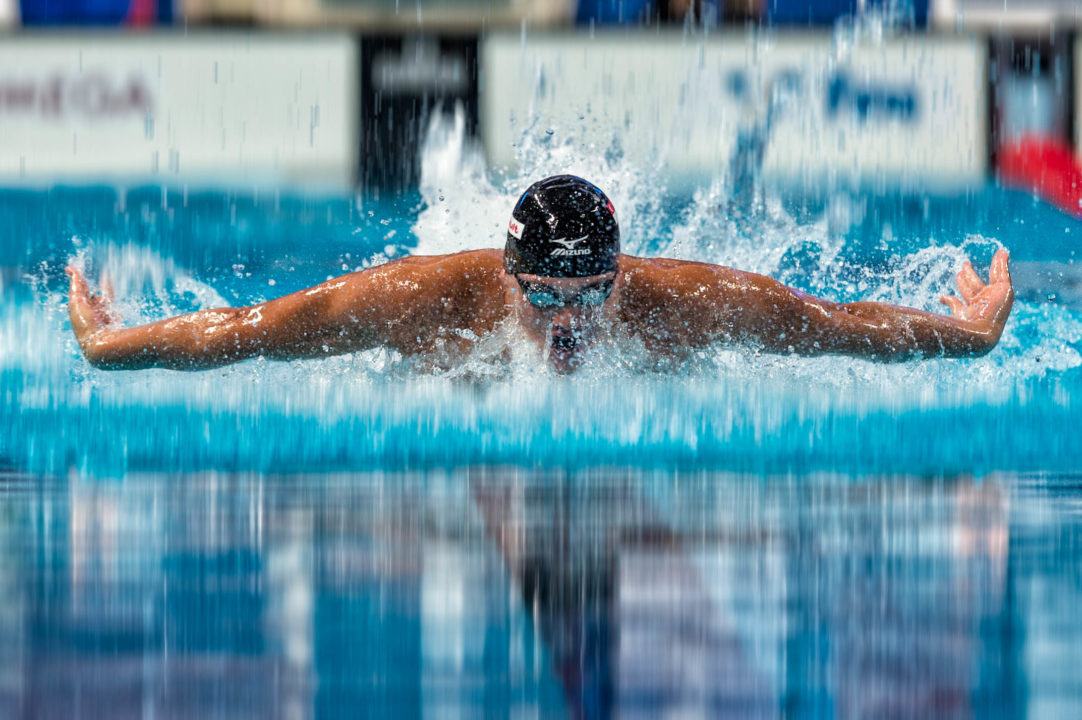Courtesy of Gary Hall Sr., 10-time World Record Holder, 3-time Olympian, 1976 Olympic Games US Flagbearer and The Race Club co-founder.
The first article I wrote on the late breath butterfly, as used by Olympic Champion Joseph Schooling, pertained to the advantage of increasing coupling energy as the head snaps down timed with the second down kick. There is more to this story, however, as the late breath butterfly may also reduce frontal drag.
The fastest way to swim butterfly is without breathing. Few would argue against that. However, the concept of going fast without oxygen works only in the 50 meter sprints. Beyond that, we depend on at least 50% of our energy coming from the aerobic system, so in the 100 or longer events, we must learn to breathe often.
Breathing is problematic in that the elevation of the head, whether to the side or front, will increase frontal drag and slow the swimmer down. The higher the elevation of the head and shoulders, the more vertical the body becomes and the greater the frontal drag. Unlike breaststroke, where the body comes to nearly a screeching halt when the shoulders are elevated and the thighs brought forward, in butterfly, the speed never goes to near zero. Therefore, maintaining a relatively horizontal body position is more important in butterfly than in breaststroke.
See the 100m butterfly 2016 Olympic Final:
Every Detail Counts
I refer to swimming as the sport of millimeters, tenths of seconds and degrees. In other words, the little details matter. Using the late breath butterfly technique is yet another example of that. The difference with this technique is that rather than lifting the head up early in the pulling cycle, the swimmer keeps the head down up to a tenth of a second longer. The head is lifted for the breath when the hands are further back in the pulling cycle. With the late breath the head is kept in the tucked down position as long as possible, rather than lifting it early and holding it up longer. Once it is elevated, it is then brought back down quickly, timed with the hand entry to maximize the coupling energy with the down kick. The head is held out of the water for less time.
By keeping the head down just a tenth of second or so longer, the swimmer maintains a lower drag position for that much more time, resulting in less deceleration. Less deceleration means the swimmer’s speed doesn’t slow as much and less work is required to get the speed back up on the next down kick.
In the 1924 Olympic Games, Johnny Weissmuller won the 100 m freestyle swimming with his head out of the water in a time of 57 seconds. Ironically, his rationale for doing so was to reduce frontal drag. He did not realize he was increasing frontal drag with his head out of the water, but he was so talented, he won anyway.
Function Over Form
The physics of frontal drag have not changed since then. It looks beautiful and graceful to see a butterflyer extending the head up and out of the water, holding that position while gliding forward. If we had the dolphin’s tail and could propel ourselves up and over the water, then having the head out would be a great idea, but we don’t have that much strength. Too much of the body remains under water during the breath, causing tremendous frontal drag.
One of the reasons coaches don’t like the late breath is that it looks weird. It is not as graceful looking as the early breathers. We also associate this technique with six year old swimmers, trying to learn to do butterfly for the first time. Since most of them don’t have the strength yet to get their arms around quickly, they take a short pause at the end of their pull, with the hands at their sides. Then they lift the head for the breath and recover their arms over the water. It is easier for them to do the butterfly stroke without breathing during the pulling phase. When older swimmers use this technique, there is guilt by association.
Experimenting
The late breath technique can be done with the same high stroke rate as the early breath, but like every other technique, it must be practiced. At The Race Club, we fully understand that one technique does not work equally well for all swimmers. We keep an open mind about which technique may be the best for each swimmer.
Later this summer, I look forward to testing and comparing the frontal drag forces and propulsion forces with the early versus late breath techniques in butterfly using our new drag/propulsion technology and will report back on our findings. In the meantime, don’t be afraid to try the late breath butterfly technique. After all, the six year olds may have it right.
Yours in swimming,
Gary Sr.

Gary Hall, Sr., Technical Director and Head Coach of The Race Club (courtesy of TRC)
Like The Race Club on Facebook
Follow The Race Club on Instagram
Follow The Race Club on Twitter
Connect to The Race Club / Gary Hall Sr. on Linkedin
THE RACE CLUB
Because Life is Worth Swimming, our mission is to promote swimming through sport, lifelong enjoyment, and good health benefits. Our objective is for each member of and each participant in The Race Club to improve his or her swimming performances, health, and self-esteem through our educational programs, services and creativity. We strive to help each member of The Race Club overcome challenges and reach his or her individual life goals.
 The Race Club provides facilities, coaching, training, technical instruction, video, fitness and health programs for swimmers of all ages and abilities. Race Club swim camps are designed and tailored to satisfy each swimmer’s needs, whether one is trying to reach the Olympic Games or simply improve one’s fitness. Our programs are suitable for beginner swimmers, pleasure swimmers, fitness swimmers, USA swimming or YMCA swimmers, or triathletes; anyone who wants to improve swimming skills. All of our Race Club members share an enjoyment of being in the water and use swimming to stimulate a more active mind and body.
The Race Club provides facilities, coaching, training, technical instruction, video, fitness and health programs for swimmers of all ages and abilities. Race Club swim camps are designed and tailored to satisfy each swimmer’s needs, whether one is trying to reach the Olympic Games or simply improve one’s fitness. Our programs are suitable for beginner swimmers, pleasure swimmers, fitness swimmers, USA swimming or YMCA swimmers, or triathletes; anyone who wants to improve swimming skills. All of our Race Club members share an enjoyment of being in the water and use swimming to stimulate a more active mind and body.

Was 1924 meters or yards??